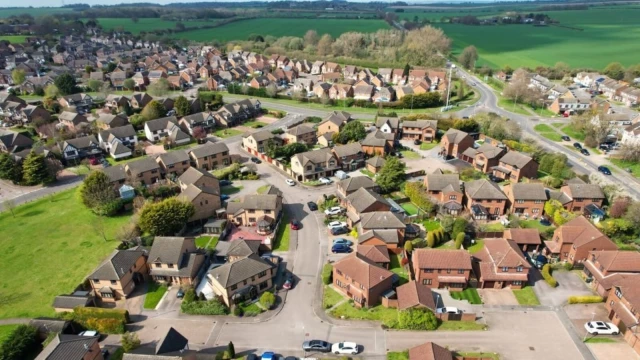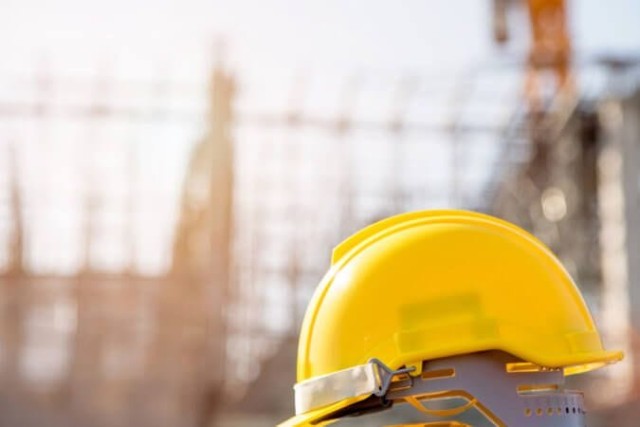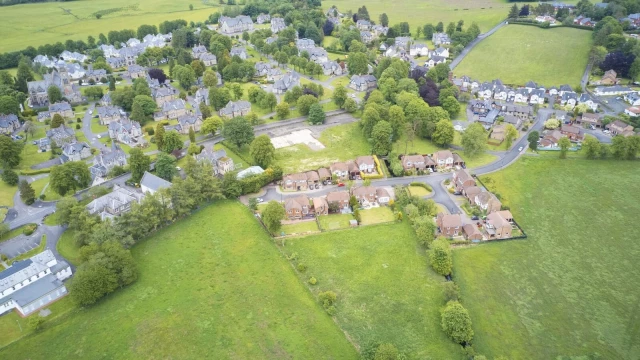Read next
The latest news, updates and expert views for ambitious, high-achieving and purpose-driven homeowners and property entrepreneurs.


Data centres and the Green Belt are two concepts you might not immediately associate with one another.
What about data centres in the Green Belt?
While right now it might sound like a far-fetched idea, there have been recent talks that some Green Belt land will be opened up to make way for these sizable data farms.
But what exactly will this look like for the Green Belt and is it a good thing or bad?
Join us as we discuss the ins and outs of this nuanced topic, covering everything from exactly what a data farm is, to how these centres can be delivered as sensitively as possible.
Here we go.

If, like me, you’ve never really thought about how and where data is stored and assumed it was more magic than science, turns out, you couldn’t be more wrong.
Who would have thought?!
As it happens, all of that data needs to be stored somewhere, which is where data centres come into play.
A data centre is a large-scale specialist facility that houses extensive computing systems, including servers, storage infrastructure and networking equipment, along with the substantial power and cooling requirements needed for artificial intelligence (AI).
The buildings incorporate essential mechanical and electrical services to maintain continuous operations and provide critical computing infrastructure for businesses, government bodies, AI applications and diverse organisations.
They require a few key design features to help them run efficiently, including (but not limited to) advanced HVAC (heating, ventilation, and air conditioning) systems, sophisticated security solutions, and a whole lot of space.
While giants like Amazon, Meta, and Google have data centres all of their own, smaller companies will rent space in an existing data centre and use the equipment and services the facility offers.

If you thought data centres were solely the domain of Silicon Valley, think again. Data centres are firmly rooted in the UK and are here to stay.
The UK hosts a range of prominent data centres, including Telehouse North in London, Equinix LD4 in Slough, VIRTUS Stockley Park Campus in Uxbridge, KAO Data Campus in Harlow, and the Global Switch London Campus. These centres play a crucial role in powering the nation’s digital economy.
In addition to existing sites, new proposals are pushing boundaries, with plans for data centres in Green Belt areas generating significant attention. Notable examples include the East Havering Data Centre which aspires to be Europe’s largest, and a proposed facility in Abbots Langley, Hertfordshire.
Still unsure about the importance of data centres? Don’t just take our word for it - their critical role in the country’s digital infrastructure was recently reaffirmed with a prestigious new designation.
Let’s explore what this means, shall we?
In September 2024, data centres were newly designated as Critical National Infrastructure (CNI), a classification that covers other important infrastructure like water, energy and emergency services systems.
Crazy, right?
The official government definition describes CNI as “National assets that are essential for the functioning of society, such as those associated with energy supply, water supply, transportation, health and telecommunications.”
But what does this look like in practice?
In a nutshell, the data sector will receive greater government support during any major incidents such as extreme weather events or cyber attacks that could threaten the operations of these centres.
The designation will also see a team of officials be established, their sole purpose being to monitor any potential threats against data centres and to respond effectively should any serious incidents take place.
Given the rapid acceleration of AI in recent months, coupled with the fact that data centres generate an estimated £4.6 billion in annual revenue in the UK and are projected to support 678,000 jobs by 2025, it’s no surprise that the government has chosen to focus a substantial amount of attention here.
Of course, this focus was also reflected in some recent changes to the National Planning Policy Framework (NPPF).
In the interests of keeping you interested, we will keep this brief.
As well as earning the CNI protection, a series of changes were announced in a newly updated NPPF (2024) that will impact data centres and how local councils will be required to invest in them.
The first key NPPF change relating to data centres is the introduction of a new paragraph 86b, which would call for local planning policies to outline criteria and pinpoint sites for local and inward investment. In the past, it was one or the other as opposed to both being required.
But that’s not all.
Paragraph 87a expands on this point, highlighting that “planning policies and decisions should recognise and address the specific locational requirements of different sectors”, including ”clusters or networks of knowledge and data-driven, creative or high technology industries; and for new, expanded or upgraded facilities and infrastructure that are needed to support the growth of these industries (including data centres and grid connections)”.
Translation? The new NPPF confirms that LPAs adopting local plans and deciding on planning applications need to recognise and make room for the needs and locational requirements that data centres demand.
I know what you’re thinking: “How does this all relate to the Green Belt?” Great question.

In June 2024, shortly before taking leadership, the Labour Party unveiled its manifesto, revealing its keen focus on housing delivery, easing the cost of living crisis, and fostering economic growth through strategic initiatives, including greater investment in the nation’s data centres.
The manifesto promised to “ensure our industrial strategy supports the development of the Artificial Intelligence (AI) sector (and) removes planning barriers to new datacentres.”
Then Labour was elected, and in a matter of days, Deputy PM Angela Rayner recovered two dismissed appeals for data centres on Green Belt land in Buckinghamshire and Hertfordshire for reevaluation.
This news sparked significant discussion at the time, raising questions about its implications not just for Buckinghamshire and Hertfordshire, but also for the future of Green Belts across the country.
Of course, it’s unlikely that sprawling data centres would be erected on the open fields of green that the Green Belt was created to protect. Rather, these centres would be built on ‘Grey Belt’ land.
But let’s take a step back and remind ourselves of exactly what the Green Belt is.
A quick refresher, the Green Belt is a land use policy that was introduced almost 100 years ago to contain urban sprawl and maintain the openness of the countryside. While it’s often mistaken as an environmental policy, none of the Green Belt's five key purposes mention the environment at all.
It is generally very difficult to build on Green Belt land unless the proposal meets one of the Green Belt exceptions, or if there are very special circumstances at play. However, the government recently announced meaningful Green Belt reform, loosening up restrictions around development on ‘Grey Belt’ land within the Green Belt.
What is Grey Belt land? In short, it’s land within the Green Belt that is environmentally overvalued and contributes little to the key purposes of the Green Belt.
Now we’ve got the Green Belt basics covered, let’s explore why these areas have such potential to be used for data centre development.

Let’s start with a look at the opportunities the Green Belt presents, then round out the chat with an overview of its limitations.
Data centres require a lot of space. And where is there an abundance of space? England’s Green Belt, which spans 16,384 km2 and is, for the most part, undeveloped.
This is an obvious draw card, with open Green Belt land often preferred by developers over brownfield sites due to its lack of contamination and the absence of existing structures, making it a less complex and more economically viable venture.
As well as the vast amount of space the Green Belt offers, much of it is well-connected to existing settlements and infrastructure, making it ideally placed for development.
Why is this important?
If a data centre is well-connected rather than parked in the middle of nowhere, it can leverage existing roads, public transport, and utilities, preventing the need for creating costly new infrastructure.
And it doesn’t stop there.
There are also appealing economic benefits that shouldn’t be overlooked. The introduction of data centres to an area means job creation in construction, maintenance, and IT roles.
Additionally, the increase in workers in the area is likely to bring a boost in foot traffic to local shops, cafes, and restaurants - an outcome that most small businesses would no doubt welcome.
While it would be ideal to situate these data centres in bustling cities like London that are already built up, the reality is that there aren’t enough suitable sites available to host what’s required, which is why the Green Belt is being considered as an alternative location.
As we’ve said, it’s unlikely these data farms will be located in the middle of a lush, isolated meadow that meets all of the Green Belt’s five key purposes with flying colours. Instead, any data farms that gain approval will most likely be built on overvalued Grey Belt land.
Now for the other side of the story.
While there are benefits for developers in utilising the Green Belt for data centres, there is always going to be pushback to any suggestion of construction in these protected areas of England.
With this in mind, the first major red flag about developing data centres in the Green Belt is the inevitable community backlash.
When development in the Green Belt is granted approval, there is often fear among locals that it could set a precedent for the approval of other types of development, reducing the protected area’s integrity.
As well as the fear of future development, there is worry about the load new developments will place on existing infrastructure, potentially creating traffic congestion and parking issues.
Think about it: if hundreds of new people flood an area, that is going to place an inevitable strain on existing resources, which is likely to upset locals who’ll have to bear the brunt of that chaos.
Of course, another potential issue is the amount of energy data centres require to operate. Staggeringly, large data centres can require the same amount of energy as 10,000 homes.
The repercussions of this immense energy use were seen in west London a few years ago when housing developments under construction were halted due to insufficient grid capacity - a problem largely driven by the increasing presence of data centres in the area.
Beyond energy issues, the potential habitat destruction is also cause for concern. Given how much space data centres demand - roughly 10,000 - 100,000 square feet, with hyperscale centres far exceeding these dimensions. - there is resistance to the idea that Green Belt land would be ripped up and replaced with something that’s, well, not so green.
Added to this point is the argument that building on the belt fundamentally contradicts the Green Belt’s objectives. Given the Green Belt was established to restrict development, maintain the character of rural areas, and keep the countryside open, to many, the idea of building anything on the Green Belt is indefensible.

We’ve heard the pros and cons of building data centres in the Green Belt but no matter which side of the argument you're on, given the meteoric rise of AI and automation, it’s almost certain that more of these centres will crop up on England’s Green Belt in the coming years.
So, how can we use design to ensure what is built aligns as closely as possible with the principles of the Green Belt?
Here are our thoughts.
In 2025, sustainability must be a priority in all major developments. With this in mind, incorporating sustainable energy solutions into data centre design is a must.
This might include:
In addition to incorporating sustainable features, it’s also important to design in line with the Green Belt’s primary purpose of retaining the openness of the countryside.
Though difficult, there are some ways you can use design to minimise the disruption a building has to the openness of the countryside.
Here are a couple of ideas:
Engaging the local community is essential when planning a data centre in the Green Belt.
Allowing residents to voice their concerns and share their preferences not only helps incorporate valuable feedback into the final design but also reduces resistance to such large-scale developments.
By actively listening to local stakeholders and addressing their views, developers can foster a sense of inclusion and shared purpose. This helps to ensure that residents are part of the process, rather than feeling steamrolled by a project imposed upon them without consultation.
Suggestions for incorporating community feedback into the design include:
These measures help to build a development that respects its surroundings while maintaining transparency and trust with the community.

Data farms, like any other developments, must follow the standard planning permission process. This involves submitting a detailed planning application to the local planning authority (LPA), which assesses the proposal against local and national planning policies.
However, developments within the Green Belt face additional scrutiny because of the aforementioned special protections afforded to these areas.
Given the scale and potential impact of data farms, these applications are frequently escalated to the Planning Inspectorate. This happens when the LPA rejects the application, or if the proposal's complexity or public interest warrants further review.
At this appeals stage, the Inspectorate evaluates the case, balancing the potential economic and technological benefits of the data centre against the harm it may cause to the Green Belt.
Developers often need to argue that their design minimises harm, incorporates sustainable practices, and brings significant public or national interest benefits, such as boosting local economies or supporting digital infrastructure.
Of course, the process may soon shift under new government priorities, with the current administration signalling its intent to fast-track developments like data centres.
As acknowledged in the consultation outcome text of the new NPPF, “Alongside delivering 1.5 million new homes, it is essential that the planning system is reformed to build the infrastructure needed to power our economy for the future and support our forthcoming industrial strategy.”
While housing is a key priority for this government, so too is fostering economic growth, which is why investing in “rapidly advancing commercial opportunities” like data centres is receiving focus.
For now, the tension between protecting the Green Belt and meeting growing technological demands remains a key challenge in shaping the future of planning decisions for data farms. It will be fascinating to see what happens over the coming years as AI and digital innovation advances further.

Let’s recap: Data centres are experiencing remarkable growth, particularly driven by advancing AI technologies, and this presents exciting opportunities for our built environment.
While many may not yet fully appreciate these facilities, they are becoming vital pieces of national infrastructure - as important to our digital age as power stations and transport networks.
These sophisticated buildings support everything from our daily internet usage to groundbreaking AI developments, making them essential to modern life.
They're helping transform previously underutilised industrial sites into high-value digital infrastructure, often incorporating cutting-edge sustainable technologies and creating new opportunities for district heating schemes and renewable energy integration.
From my perspective in planning and architecture, data centres represent fascinating examples of purpose-built technical architecture, combining innovative design with practical functionality, and I think that should be something we celebrate, not dismiss.
If you’d like to learn more about the Green Belt, we’d highly recommend reading some of our popular other blogs on the topic, or even purchasing our firm’s debut book, ‘Green Light to Green Belt Developments’.
If you have a project you’d like to discuss further, we’d love to hear from you. Don’t hesitate to get in touch with our friendly team to learn if we can help you with your project.

Urbanist Architecture’s founder and managing director, Ufuk Bahar BA(Hons), MA, takes personal charge of our larger projects, focusing particularly on Green Belt developments, new-build flats and housing, and high-end full refurbishments.
We look forward to learning how we can help you. Simply fill in the form below and someone on our team will respond to you at the earliest opportunity.
The latest news, updates and expert views for ambitious, high-achieving and purpose-driven homeowners and property entrepreneurs.
The latest news, updates and expert views for ambitious, high-achieving and purpose-driven homeowners and property entrepreneurs.










We specialise in crafting creative design and planning strategies to unlock the hidden potential of developments, secure planning permission and deliver imaginative projects on tricky sites
Write us a message